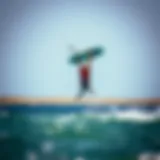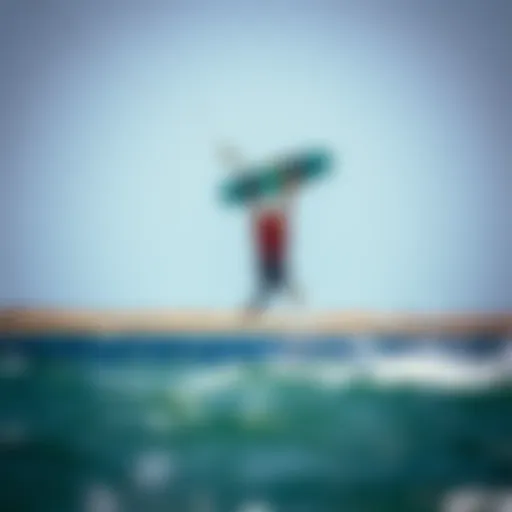Explore the Best Kiteboarding Kites for Sale
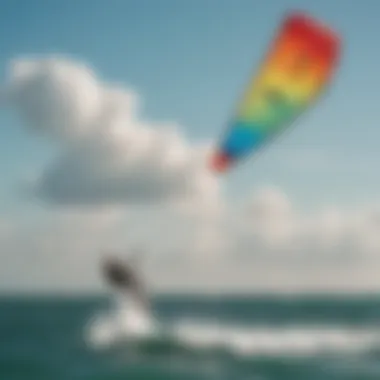

Intro
Kiteboarding is more than just a sport; it’s a lifestyle for many. Enthusiasts from all walks of life are drawn to the rush of gliding over the water, propelled by the wind and a well-selected kite. With the surge in kiteboarding’s popularity, choosing the right equipment can feel like navigating a maze. From the basics of different kite types to the nitty-gritty details of brands, there’s a lot to unpack.
This guide aims to unravel the complexities of the kite market, providing a structured path through everything a kiteboarder needs to consider before making a purchase. Whether you're just getting your feet wet or have years of experience under your belt, understanding what makes a kite right for you can substantially elevate your experience and skills on the water.
In this guide, we will explore:
- Techniques: Covering foundational maneuvers as well as advanced tricks to take your skills up a notch.
- Gear Reviews: Highlighting the latest equipment and essential accessories that can enhance your kiteboarding experience.
- Maintenance and Safety: Offering insights on how to care for your gear and best practices that keep you safe.
- Market Insights: Understanding trends that can offer an edge in selecting the best kite for your budget and style.
With this, let’s get into the nitty-gritty of kiteboarding techniques that lay the groundwork for any kiteboarder.
Understanding Kiteboarding Kites
Understanding kiteboarding kites is essential for anyone wanting to dive deep into the sport or even those just considering giving it a try. The right kite can mean the difference between a fulfilling experience on the water and a frustrating day of tangled lines and lost control. Grasping the concept of kites and their components enables riders to make educated decisions about gear that complements their style, skill level, and riding conditions.
As kiteboarding continues to evolve, the significance of comprehending kites extends beyond just function; it also speaks to safety, performance, and the overall enjoyment of the sport. Without a sound understanding of how kites work, a newbie may find themselves overwhelmed at the beach, while seasoned riders may miss the nuances that can advance their riding prowess. Therefore, kicking things off with a clear picture of what kiteboarding kites are all about is key.
What is Kiteboarding?
Kiteboarding is a water sport that combines elements of surfing, windsurfing, and paragliding. Picture the thrill of gliding across the water, powered by the wind's pull on a kite. Riders typically use a board that’s strapped to their feet, allowing for jumps, tricks, and high-speed navigation across the surface. This sport appeals to adrenaline junkies and casual water enthusiasts alike, as it offers the ability to execute breathtaking aerial performances or enjoy a more leisurely day on the water.
The Anatomy of a Kite
The anatomy of a kite is a topic rich with details that play a crucial role in how the kite behaves in various wind conditions. Each part of the kite contributes to its functionality and ultimately affects the performance of the rider. Understand this structure to truly appreciate how these kites transform wind into a thrilling ride.
Leading Edge
The leading edge of a kite is the first portion that slices through the wind, and it's critical in defining kite performance. Its primary characteristic is the shape; whether rounded or flat, this can greatly influence lift and stability. A well-designed leading edge offers a reliable performance, allowing a smoother ride.
One unique feature of leading edges is that they often contain bladders which inflate to maintain the shape and ensure aerodynamic efficiency. However, these can be prone to punctures, advocating for riders to regularly check them for signs of wear and tear. The benefit of a robust leading edge is that it gives the kite the ability to quickly generate lift, especially when maneuvering through dynamic wind scenarios.
Trailing Edge
The trailing edge works in harmony with the leading edge, being the last point that interacts with the wind. It mainly affects drag and turning performance. A well-structured trailing edge can reduce turbulence, allowing for smoother transitions in flight.
Many kite designs feature a shaped angle at the trailing edge, optimizing the kite's ability to cut through the air efficiently. This characteristic can dramatically influence control, making it a popular choice when it comes to advanced kiting techniques where precision is paramount. While a significant advantage, a trailing edge that isn't well-maintained can lead to lost performance, underlining the importance of care and seasonal checks.
Struts and Bladders
Struts and bladders play a vital role in maintaining the overall shape of the kite, impacting both performance and durability. Struts are supportive poles that help distribute the kite's air supply evenly, making the kite stable and responsive. They provide the structure needed to keep the kite in the right shape while flying.
Bladders, on the other hand, are inflatable components that ensure the kite maintains its form against pressure changes. Their resilience means they can withstand the stresses of flying while providing the necessary buoyancy. The lightweight nature of these materials makes them essential for performance but also introduces a downside; they can be susceptible to leaks and require diligent maintenance to keep them in peak condition.
Types of Kiteboarding Kites
Understanding the types of kiteboarding kites is crucial for enthusiasts who want to make informed decisions in selecting the right equipment. Each kite type comes with its unique characteristics, making it important for riders to grasp the specific features and benefits of each before investing. Different kites serve various purposes, and knowing what fits your style can dramatically affect performance and safety on the water.
Foil Kites
Design Features
Foil kites are designed to be light yet responsive. They often comprise a fabric wing with air chambers that inflate when pulled along by the wind. One significant aspect of their design is the lack of a solid frame—this makes them remarkably portable and easier to pack when compared to other models. The absence of a rigid frame means these kites can handle gusty winds better, as they adapt to varying air conditions without sustaining damage easily. A key feature of foil kites is their efficiency in low wind conditions, allowing riders to enjoy sessions even when breezes are gentle.
Best Use Cases
Foil kites excel in various scenarios, particularly in light wind environments. They are well-suited for free ride and mountain kiteboarding due to their adaptability. Riders who often find themselves at locations with unpredictable winds will appreciate how foil kites navigate through these conditions. Their lightweight nature also permits longer flights, as they can be launched with less force and remain aloft with minimal effort. However, in stronger winds, their performance may become less manageable, signaling a need for skill in adjusting riding techniques.
LEI (Leading Edge Inflatable) Kites
Advantages
One of the most notable aspects of LEI kites is their distinct design that includes inflatable edges, providing increased stability and ease of handling. This design allows them to generate more power by capturing greater wind, making them ideal for beginners and experienced riders alike. The inflatable leading edge also contributes to easier relaunching, which means if the kite goes down, riders can have it back in the air with much less hassle.
Considerations for Selection
When selecting an LEI kite, one must consider the riding style and the desired conditions. Not all LEI kites are the same; features like aspect ratio, size, and material play significant roles in performance. Higher aspect ratio kites generally fly faster, which might appeal to those seeking adrenaline rushes. Conversely, riders looking for stability and control may prefer lower aspect ratio options. Awareness of personal proficiency and local wind conditions is essential, as mistakes can lead to undesirable experiences.
Mixed Kites
Performance Characteristics
Mixed kites are often found in the middle ground, combining attributes of both foil and LEI kites. They generally provide versatility, making them a go-to for many riders who don’t want to pigeonhole themselves to one specific style. These kites often offer good lift and stability, which can be particularly useful while learning new tricks or handling varying conditions. Their performance can vary, so it’s essential for riders to understand the intricacies of their chosen mixed kite to maximize its potential.
Suitability for Various Conditions
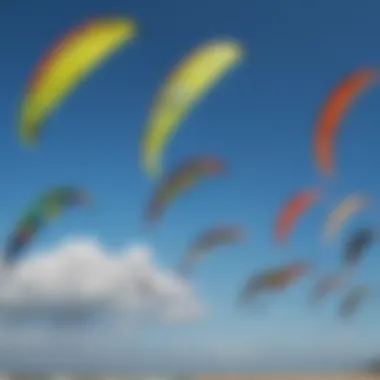

When it comes to conditions, mixed kites shine in diverse environments. Their hybrid nature adapts well to both light and moderate winds, granting accessibility to a broader range of kiteboarding enthusiasts. This adaptability is precisely why they are popular among progressing riders who are still finding their footing in the sport. However, those venturing into extreme conditions need to be mindful that mixed kites might not perform as well as specialized options there, meaning riders must still assess their surroundings closely before taking off.
Choosing the Right Kite
Selecting the appropriate kite is fundamental in the kiteboarding experience. It can mean the difference between flying high and sailing smoothly across the water or landing with a crash. A well-chosen kite not only enhances performance but also boosts the rider's confidence. Many novice riders often underestimate how significant kite size and type can affect their ride, which makes understanding these variables pivotal. So, when standing in that shop or browsing online, be ready to think carefully.
Factors to Consider
Rider Weight
Rider weight plays a crucial role when considering which kite to purchase. Your weight helps determine the size of the kite you should use. Generally, heavier riders require larger kites to achieve the lift necessary for a good ride. Conversely, lighter people can often go for smaller kites. This isn't just a matter of preference but practicality; picking a kite that aligns with your weight can significantly enhance performance and safety.
A helpful point to remember is that as the rider's weight increases, adjusting for wind conditions becomes all the more important. A larger kite will catch more wind; thus, it's perhaps a more beneficial choice for those who find themselves often battling stronger breezes. However, larger kites come with their own considerations as well. They can be more challenging to handle in gusty conditions or for newer riders.
Wind Conditions
Wind conditions are another vital aspect in selecting the right kite. Understanding how different kites react in varying winds ensures the rider can enjoy their time on the water without struggling. Kites are often categorized for use in light, moderate, and strong winds.
For instance, if you live in an area known for gusty winds, a foil kite may be your best bet due to its versatility. On the other hand, riders who often find themselves in higher winds might prefer a smaller LEI kite that's easier to manage. A popular choice when dealing with variable winds is to have a couple of kites in different sizes, enabling you to adapt to changes as they come.
Additionally, be mindful of kite design features that cater to specific wind strengths. Some kites are designed with increased stability during high winds, which means less chance of being flipped upside-down. This unique feature can be beneficial especially for intermediate or advanced kiteboarders who tackle challenging conditions.
Skill Level
Your skill level immensely influences your choice of kite. Beginner riders might want to stick with a kite that has a wider wind range and is easier to control, often a larger LEI kite. Why do we say this? A more forgiving kite helps instill confidence in new riders, allowing them to practice without disproportionate frustration.
On the other hand, experienced kiteboarders may gravitate towards smaller, performance-driven kites that give them the agility needed for tricks and jumps. Such kites, however, require excellent technical skills, as they can be less forgiving, sometimes leading to challenging situations if not handled with care.
It's worth noting that as one's skill evolves, so too should the kite choice. This gradual progression keeps the experience fresh and exciting but necessitates a good understanding of both personal development and equipment characteristics.
Understanding Kite Sizes
Size Chart Guides
Size chart guides serve as essential tools for kiteboarders seeking clarity on which kite size corresponds to their weight and wind conditions. These charts are often provided by manufacturers and can usually be found on websites or product manuals. Effective use of these guides can enhance rider safety and performance.
Every chart will typically break down size recommendations according to weight categories while keeping in account wind strengths. They serve as a basic blueprint, helping you gauge where you fit within specific conditions.
A vital point to keep in mind is that size charts are not absolute; adjustments may be needed based on your experience or specific conditions you might encounter. Therefore, maintaining flexibility and being willing to adapt is essential.
Optimal Size for Conditions
Determining the optimal size for current conditions can greatly enhance your kiteboarding experience. Sizing your kite appropriately can lead to better performance and stability in the air. This means considering both the current wind speed and the size of the kite you choose.
For instance, in light wind, a larger kite will capture more air, making it easier for you to glide. Conversely, during stronger winds, a smaller kite is often the smarter choice, providing increased control and responsiveness.
A strong feature of this concept lies in how it can elevate your riding. A kite that matches the conditions ensures that you can perform tricks effectively, boost high, or simply enjoy a seamless ride.
Overall, assessing the right kite size not only boosts enjoyment but also promotes a safer kiteboarding experience.
"The right kite size for the wind conditions can transform a mediocre session into one filled with exhilaration!"
Understanding these details can help you make more informed decisions, ensuring that every time you take to the water, you’re equipped for an awesome kiteboarding adventure.
Popular Brands in Kiteboarding
When it comes to kiteboarding, the brand you choose can significantly influence the equipment’s performance and, ultimately, your experience on the water. The kiteboarding market is full of options, but well-established brands typically offer more in terms of reliability and innovation. Consumers can benefit from understanding which brands are at the forefront of the industry and what sets them apart. This leads to informed decisions, ensuring that you’re not just picking a kite, but investing in a piece of equipment that aligns with your goals and style of riding.
Market Leaders
Brand Comparisons
In the kiteboarding realm, brand comparisons unveil essential factors for riders seeking optimal performance. Different brands often target specific aspects of kiteboarding, such as durability, versatility, or ease of handling. For example, brands like Cabrinha and Slingshot are globally recognized for producing robust kites that withhold harsh sea conditions, making them a go-to choice for numerous enthusiasts.
When contrasting these brands, key characteristics include their design philosophies, user-friendly features, and customer service. Cabrinha’s switchblade kites feature unique technology for better control in varying conditions, while Slingshot’s RPM focuses on improving kite response time. Evaluating these comparative elements can aid in choosing the right kite for your distinct riding style, and it’s not just a superficial decision; the specific nuances can either enhance or deter your riding experience.
Unique Selling Points
Unique selling points are pivotal in a crowded market. Many brands differentiate themselves by introducing innovative features that cater to specific rider preferences. For instance, Naish Kites emphasizes sustainability, utilizing eco-friendly materials in their kite production, which resonates with environmentally-conscious consumers. Additionally, the unique size and shape variations offered by North Kites attract riders who prefer customizing their gear based on personal taste and regional conditions.
What’s more, these unique features often extend to performance benefits, offering lighter kites that glide better and respond faster to rider inputs. For riders considering performance alongside values, assessing these unique traits is crucial.
Emerging Brands
Innovative Technologies
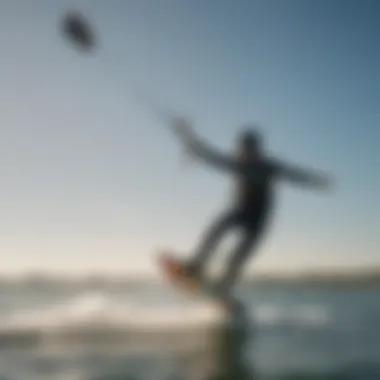

Emerging brands in kiteboarding are revolutionizing the sport by incorporating cutting-edge technologies that enhance kite performance and safety. Take Ozone Kites as an example, which implements advanced materials and aerodynamic designs. These innovations contribute significantly to stability in high winds and responsiveness in tricky situations. For many riders, the technology behind their gear can be a game changer, pegging these brands as serious contenders against market leaders.
Furthermore, the continuous adoption of lighter, stronger fabrics not only enhances performance but addresses longevity issues often faced by traditional kites.
Customer Feedback
Focusing on customer feedback is another way emerging brands shape their offerings and improve user experience. Brands like Flysurfer often utilize direct input from riders to optimize their products. This feedback loop ensures that each new kite release corresponds with real-world use, providing features that matter most to users.
Positive reviews about the ease of setup or specific performance under various conditions can indicate greater reliability. However, new brands may also face criticism early on, often about durability or inadequate customer support as they begin. It’s wise for buyers to consider this feedback to gauge whether an emerging brand meets their expectations.
"Selecting a kite isn't just about brands; it's about finding the one that harmonizes with your unique style and aspirations on the water."
In summary, understanding the landscape of popular brands in kiteboarding—not only through established giants but also daring newcomers—provides riders with a well-rounded perspective on what’s available. As kiteboarding continues to evolve, so too will the players in the game, each striving to meet the dynamic needs of kiteboarders everywhere.
Where to Buy Kiteboarding Kites
Finding the right kiteboarding gear is crucial for any kiteboarding enthusiast, from newbies to veterans. The place where you buy your gear plays a significant role not just in fitting your budget, but also in ensuring you get quality products that match your needs. With so many options available, understanding the benefits and considerations of purchasing from different sources can enhance your overall kiteboarding experience.
Online Retailers
Going online for your kiteboarding kites has become increasingly popular. Not only do online retailers offer a wider selection, but they also provide convenience and often better prices. Many kiteboarders prefer browsing from the comfort of their homes instead of dealing with the hustle and bustle of a store. Here's a deeper look at some aspects of buying online.
Website Reviews
When searching for sites to purchase kiteboarding kites, website reviews can be your best ally. A crucial part of the buying process, reviews provide insights into customer experiences with specific brands and online sellers. These reviews shed light on various aspects such as product quality, customer service, and shipping experiences. A well-reviewed site can alleviate many worries, as you can gauge reliability before pulling the trigger on a purchase. On the flip side, some reviews can be overly optimistic or downright misleading. Hence, it’s advisable to look for patterns in feedback rather than relying on one-off reviews.
Shipping and Returns Policies
The shipping and returns policies of an online retailer are vital considerations. Every site has different rules about how they handle shipping costs and what you can expect if your product is not as described. A transparent policy about returns can save many headaches by allowing for easy exchanges or refunds if the kite doesn’t match your needs. Additionally, understanding the shipping times is paramount; it prevents the disappointment of waiting weeks only to find out your kite is stuck somewhere. Always check if a retailer offers free shipping above a certain purchase price—it’s a handy perk.
Local Shops
Buying from local shops holds an allure of its own. It allows you to interact with knowledgeable staff who can offer valuable advice on the best kites suited for your individual needs. When purchasing from a local retailer, the benefits can outweigh the convenience of online shopping in many cases.
Benefits of In-Person Shopping
One of the biggest benefits of in-person shopping is the chance to physically assess the kites available. This allows you to inspect the materials, check the size, and even feel the weight, giving you a tactile sense of what works best for you. Additionally, local shops provide an opportunity to speak to experts who can answer your specific questions right away, something online forums or chatbots just can't match. They might even let you test out kites in a controlled environment. However, keep in mind that local shops may have a limited selection compared to online retailers.
Supporting Local Businesses
By opting to buy from local stores, you’re also supporting local businesses which is an essential aspect of community sustainability. When you shop locally, you can help maintain jobs in your community and contribute to its economic welfare. Local businesses often offer unique products that you won't find elsewhere, reflecting local preferences and styles. While prices may be a tad higher compared to online options, the value of personal service and community support can outweigh the cost. Think of it this way: every dollar spent at a local shop is an investment in your community.
In summation, where you buy your kiteboarding gear is not just a matter of price; it involves weighing the benefits of online convenience against the personalized service that local shops provide.
Used Kiteboarding Equipment
When it comes to kiteboarding, not everyone has the budget to splurge on brand-new gear. That's where the option for used kiteboarding equipment comes into play. Buying second-hand can be a blessing for many, especially if you're just starting out or looking to upgrade without breaking the bank. This section shines a light on the importance of carefully considering used gear and how to navigate this often-misunderstood market.
Pros and Cons of Buying Used
As with any used item, purchasing second-hand kiteboarding equipment has its ups and downs.
- Cost-Effective: The most glaring advantage is the price; used kites often come at a fraction of the original cost, making it easier for beginners to enter the sport without a heavy investment.
- Wider Selection: The market for used equipment is vast, offering an array of additional brands and models that may no longer be readily available in stores.
However, there are definitely some considerations:
- Wear and Tear: Kites and accessories naturally take a beating with frequent use. You might encounter items that appear fine at a glance but may have underlying issues that could compromise safety.
- Limited Warranty: Many used items don’t come with any warranty, which means if something goes wrong, you're generally out of luck. It’s essential to weigh these factors carefully.
What to Look For
Condition Assessment
Condition assessment is crucial when evaluating used kiteboarding gear. It helps ensure that your choice meets safety standards and will perform as expected. The key components to assess include:
- Fabric Integrity: Look for signs of wear, fraying, or fading. Sturdier fabric will have a tighter weave and feel more durable. Examine the seams and check for any delamination.
- Bladders and Valves: Check for leaks by inflating the kite and listening for any hissing sounds. Any signs of deflation can be a red flag. Valves should operate smoothly and should not show any signs of cracking.
A thorough inspection can save you from potential headaches down the line, so don’t skip this step.
Understanding condition assessment is beneficial because it provides you with a clearer image of what you’re really getting. It also empowers you to make an informed decision on whether a piece of equipment is worth your investment.
Price Negotiations
Price negotiations can be a game-changer when it comes to buying used kiteboarding gear. It’s not just about getting a good deal; it’s also about finding a fair price based on what you know about the product’s condition.
- Research Market Trends: Knowing the going rates for various kites helps you to have realistic expectations. Many forums or communities, like Reddit and Facebook, can offer insight into what similar used equipment is selling for.
- Leverage Condition Info: If you noticed any imperfections during your assessment, use them as leverage in your negotiation. For example, if a kite has minor damage, don’t be afraid to propose a lower price based on your findings.
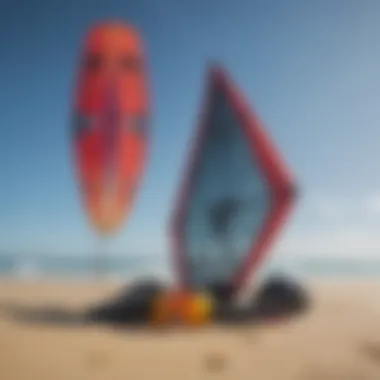

Navigating the second-hand market can be advantageous but requires some savvy. A clear understanding of price negotiations allows you to maximize value while minimizing costs. It assures you not just of quality but also that your hard-earned money is well-spent, ultimately enriching your kiteboarding experience.
Maintenance and Care for Kites
Taking care of your kiteboarding kites isn’t just a chore; it’s essential for preserving performance and extending their lifespan. Proper maintenance directly impacts safety and can save you a pretty penny down the road. When you invest time in understanding how to maintain and care for your kites, you’re not just prolonging the usability of your equipment but also ensuring a better experience each time you hit the water.
Kites undergo significant strain during use, facing wind forces and water exposure. Regular upkeep minimizes wear and tear and helps identify potential issues before they become major problems. Think of your kite like a trusty steed; you wouldn’t ride a horse that hasn’t been cared for, would you? A little attention can significantly enhance your kiteboarding experience.
Pre- and Post-Session Care
Prepping your kite before a session is as vital as the actual riding. Here are some crucial aspects:
- Inspection: Check for any rips or signs of wear. Look closely at the seams. Even a tiny tear can grow exponentially with wind pressure.
- Inflation: Make sure the bladders are properly inflated. A well-inflated kite maintains its shape and performance characteristics.
- Safety Checks: Ensure that all lines and attachments are correctly rigged. The last thing you want is a tangled line when you're trying to catch the next wave.
Once your session is over, give your kite some tender loving care:
- Rinse with Fresh Water: Saltwater can be brutal on your kite, leading to deterioration. A quick rinse with clean water removes harmful residues, ensuring the fabric remains robust.
- Drying: Avoid packing a wet kite. Let it dry completely before storage to prevent mold and mildew.
- Packing: Roll it neatly instead of folding to avoid creases which can weaken the material.
By adhering to this routine, you assure that your kite is in peak condition, ready for the next adventure.
Storage Recommendations
Now that your kite is clean and dry, how you store it is crucial. Good storage practices play a significant role in maintaining the longevity of your kite. Consider these points:
- Avoid Direct Sunlight: Excessive sun exposure can degrade the materials over time. Look for a shaded spot or use a bag that minimizes UV exposure.
- Temperature Control: Store your kites in a cool, dry place. Extreme temperatures, both hot and cold, can affect the materials.
- Organized Storage: Consider using a kite bag that has compartments for each component. It not only keeps everything neat and tidy, but also prevents unnecessary wear from items rubbing together.
- Frequent Checks: Make it a habit to check your kite’s condition even when not in use. This way, if something is off, you can catch it before your next session.
"Taking care of your kites is more than maintenance; it's about respecting the craft and ensuring you’re always ready to ride the waves."
In short, maintenance and proper care for kiteboarding kites cannot be overstated. As enthusiasts, the responsibility of keeping our gear in top shape rests on our shoulders. With mindful practices in place, you'll not only preserve your investment but also enhance each ride. Happy kiteboarding!
Safety Considerations
When you're soaring above the waves, kiteboarding can be both exhilarating and tranquil. However, the thrill comes with risks that should never be overlooked. Understanding the potential hazards and knowing how to mitigate them is crucial for not just enjoyment, but survival in this adrenaline-pumping sport. This section highlights the nuances of kiteboarding risks and discusses the essential safety gear everyone should have.
Understanding Kiteboarding Risks
Kiteboarding, while seemingly straightforward, possesses inherent risks that riders must grasp in order to navigate safely. The unpredictable nature of wind, the power of the kite, and the interaction with water all add layers of complexity. Things can go south quicker than one might expect, and a momentary lapse in attention could lead to injuries or accidents.
Here are some of the primary risks involved:
- Wind Variability: Uneven gusts can catch even the most experienced kiteboarder off guard. Understanding how to read wind patterns is essential.
- Equipment Failure: While kite gear is usually robust, wear and tear can lead to failures. Regular inspections can help catch problems before they become major issues.
- Water Conditions: Strong currents, waves, or shallow areas can present dangers that are often underestimated. Familiarizing oneself with the environment is key.
- Interaction with Others: Be it swimmers, other kiteboarders, or boats, maintaining situational awareness is vital to prevent collisions.
Recognizing these risks is the first step to ensuring safety. By being prepared, riders can enjoy the thrill of kiteboarding without compromising their well-being.
Safety Gear and Equipment
To ride the waves confidently, having the right gear is non-negotiable. Not only can the proper equipment enhance performance, but it can also play a pivotal role in safety. Let's delve into two key safety components: helmets and impact vests.
Helmets
A helmet is not just an accessory; it's a crucial piece of safety equipment. When you're high above the water, a sudden fall or impact can lead to serious head injuries. Helmets are designed specifically for extreme sports, providing protection without compromising comfort.
The key characteristic of a good helmet is its robustness combined with lightweight materials, which helps in maintaining a comfortable fit during long sessions. Many helmets today come with adjustable features, ensuring a snug fit.
A unique feature worth noting is the incorporation of integrated communication systems in some models. This allows kiteboarders to stay connected with others, providing a layer of safety by facilitating communication during rides. However, this can also be a double-edged sword; distractions could potentially lead to mishaps, so careful use is advised.
Impact Vests
When it comes to safety in kiteboarding, impact vests are just as important as helmets. Designed to absorb shocks and protect the torso, these vests offer padding in key areas such as the ribs and back. The key characteristic is their buoyancy and padding which aids in both safety and performance.
A standout feature of many impact vests is their multi-functional designs, which often include pockets for storing essentials and even built-in harnesses for added ease of use. This adaptability makes them a popular choice for many riders.
However, some might find that these vests restrict movement a bit, which can be a trade-off for safety. Still, the benefits of having that extra layer of protection far outweigh the minor inconveniences.
Future Trends in Kiteboarding Equipment
The kiteboarding industry is constantly evolving, shaped by advancements in technology and growing awareness about sustainability. As kiteboarders and enthusiasts look ahead, understanding these trends becomes crucial, whether for upgrading existing gear or making informed purchases. Manufacturers are not only focused on performance but also on creating kites that are more environmentally friendly, which resonates well with the growing community that values ecological mindfulness. This section briefly highlights the critical trends that are set to redefine the future of kiteboarding.
Technological Innovations
Technological innovation has become a game-changer in the world of kiteboarding equipment. Kites are now being crafted with state-of-the-art materials and designs, enhancing both performance and user experience. Innovations such as the use of lighter yet more robust fabrics contribute to increased durability and maneuverability. These advancements mean riders can enjoy longer sessions on the water without worrying about wear and tear.
Another notable tech shift is the integration of digital tools, like apps that track wind conditions and help optimize kite settings based on real-time data. Smart kites now come equipped with sensors that measure performance metrics, providing insights that were previously only accessible to seasoned practitioners. This means both beginners and advanced riders can train with more precision.
"The future of kiteboarding is not just about riding the waves, but understanding them."
Sustainability in Kite Manufacturing
With growing concerns about environmental impact, manufacturers are leaning towards sustainability in kite production. Kiteboarding kites are traditionally made from materials that can take years to decompose. However, new approaches focus on using recycled materials and eco-friendly production techniques. For instance, some brands are experimenting with biodegradable fabrics that not only perform well but also minimize ecological footprints.
Moreover, a shift is evident towards creating kites that encourage longer-term use and repairability. Enhanced durability helps mitigate the effects of waste while supporting a more circular economy. This trend not only benefits the planet but fosters a sense of responsibility among kiteboarders, making them more aware of the choices they make regarding their equipment.




